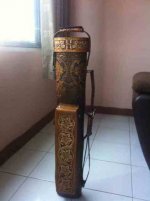Chopdoc, those cases are very guarded, and I like the idea of flying with those cases, but the lack on the art side for me. Still very cool that you actually made one of those yourself!
Thanks. That case is an endoscope case. I just made the inside.
So you are willing to compromise "protection" for the sake of art?
The way I see it, for practical purposes a cue case is a collection of compromises. There are several leading case makers, each has his talent, his following, and his designs. I don't think any one is best.
What will be best for a particular individual will be the result of their expectations which generally comes from their experience.
Personally I like box cases and I like tube cases (Fellini style). I have several examples of both and really like them.
I also dig envelope cases but I don't have one yet.
I don't think that anybody makes an "uncompromised protection case" currently, outside of perhaps something like Danbuilt road cases from Dan Dishaw...but those are hardly for daily use.
JB has put a lot of thought and experience into his cases and linings with a concentration on his ideas of protecting cues. I think he has done a fine job. Does that mean his cases are the best? No. Are they among the best? Yes, I think so.
What it really comes down to is what one personally wants in and expects from a cue case.
I don't believe that any of the leading case makers provide inadequate protection at all.
I personally do not prefer the type of case that you posted. I am not a fan of tooled leather. Yes, it is a great art. Just not my thing, it has to do with my father who introduced me to leather. He saw tooled leather as "damaged".
Tooling also requires veg tanned leather, which is IMHO far inferior to some other leathers for the purposes of protecting cues. I really dig oil tanned leather.
I was very happy to see JB make more of the oil tanned leather cases. I think they are not just superior to veg tanned cases but in fact far superior. I also think his nylon cases are probably the best value going.
To understand the durability of oil tanned leather, have a look at some good motorcycle boots. Not the pussy-whipped color-coordinated crotch rocket boots, but "real" motorcycle boots. Oil tanned. Then get a piece of thick oil tanned leather and try to cut it with whatever tool you like. Try to scrape it, ding it, scuff it. Then try that with some oil tanned leather. Then get them both wet. You know what happens when veg tan gets wet of course, you have tooled it, so you know. It needs to be sealed with coatings and that generally leaves the back side vulnerable as well as the seems which will wick up water even in a well coated case. Oil tanned? Water is a joke on oil tanned leather. The differences are positively astounding.
The tooled cases are beautiful. But as a case first and foremost they fail IMHO. Why? How can one claim to protect something with a case when said case cannot even protect itself?
My last testimony for oil tanned comes not from a pool cue case example but from my own motorcycle boots. I took a shortcut through an alley back about 1996. I was trying to get to the welding shop where I was putting together a chopper frame. What I didn't know was that somebody kept a pitbull in that alley. There was a gate...but I just had not thought anything of it as I went through. The damned dog let me get to the other end, to the other gate, then came up behind me and clamped down on my calf. He wasn't going to let me leave. Ever see a pitbull destroy a baseball bat or bowling ball? You know how powerful their jaws are. Did it hurt? Hell yeah. How was my leg? Just fine. I think the dog was pretty stunned when my other boot connected with the side of his head as I spun around. I was wearing oil tanned motorcycle boots. If I had not been then I would have very likely been in need of very fast transport to an emergency room.
There are many aspects to such a discussion and my own views are pretty well outside the norm, I know that. It's just how I see things.
.

